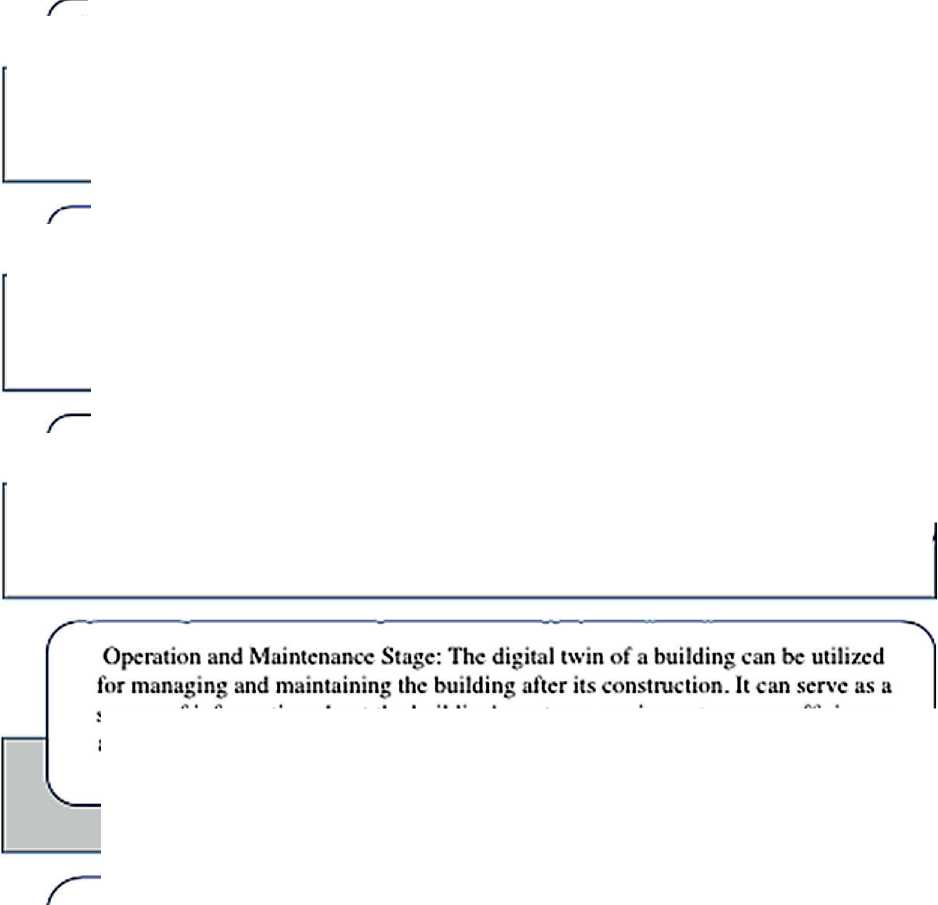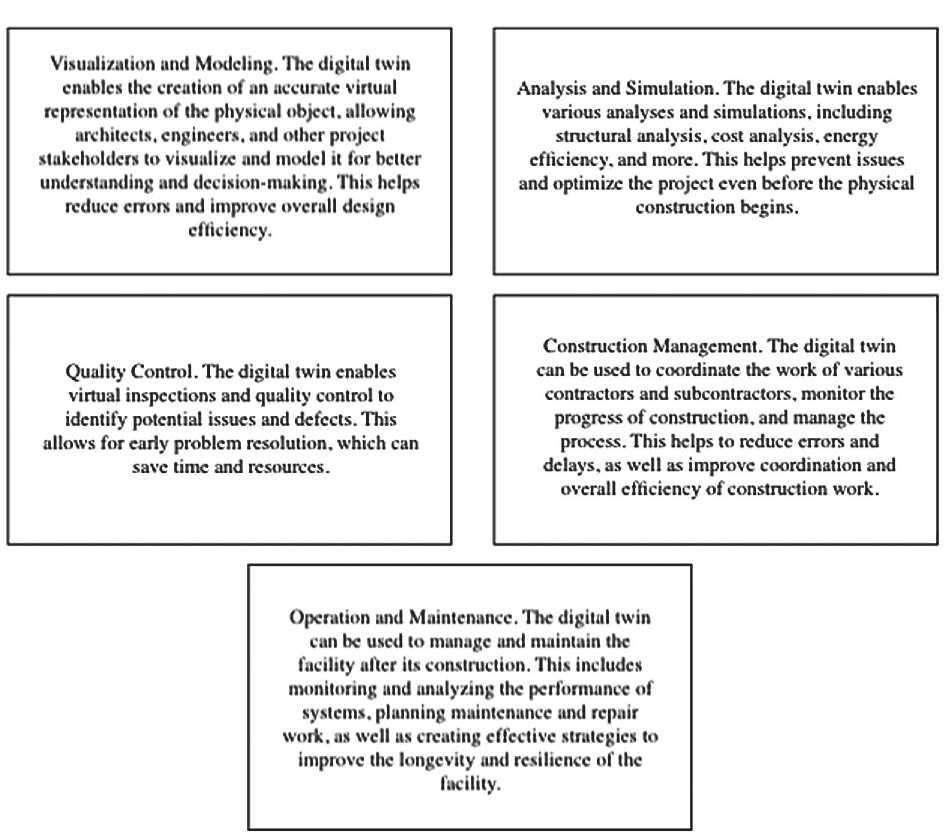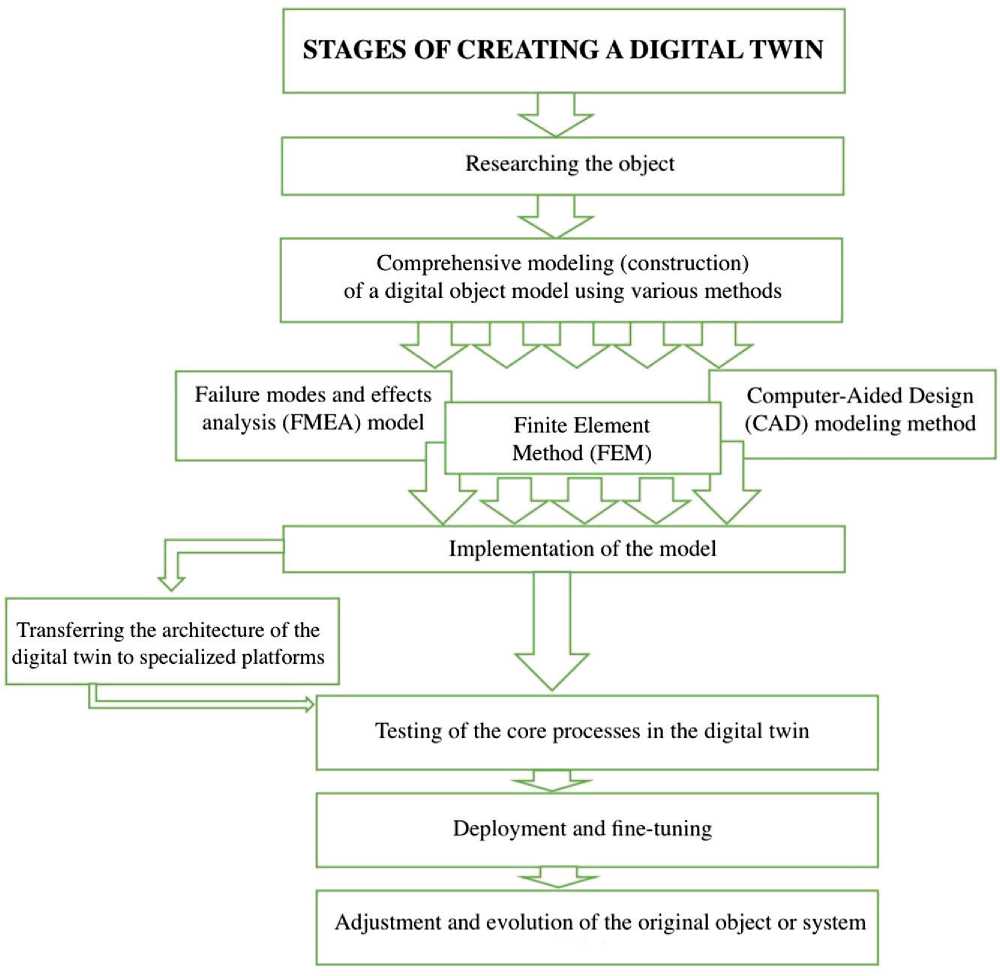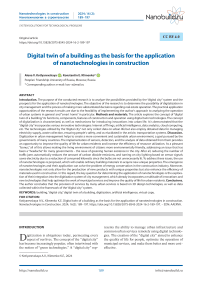Digital twin of a building as the basis for the application of nanotechnologies in construction
Автор: Kotlyarevskaya A.V., Klimenko K.E.
Журнал: Nanotechnologies in Construction: A Scientific Internet-Journal @nanobuild-en
Рубрика: System solutions for technological problems
Статья в выпуске: 2 Vol.16, 2024 года.
Бесплатный доступ
Introduction. The purpose of the conducted research is to analyze the possibilities provided by the “digital city” system and the prospects for the application of nanotechnologies. The objective of the research is to determine the possibility of digitalization in city management and the process of making more substantiated decisions regarding real estate operation. The practical application opportunities of the research results are due to the feasibility of implementing the author's approach to analyzing the operation of urban systems in general and “smart home” in particular. Methods and materials. The article explores the concept of “digital twin of a building,” its functions, components, features of construction and operation using digital twin technologies. The concept of digitalization is characterized, as well as mechanisms for introducing innovations into urban life. It is demonstrated that the “digital city” incorporates various innovative technologies: Internet of Things, artificial intelligence, data analytics, cloud computing, etc. The technologies utilized by the “digital city" not only collect data on urban life but also employ obtained data for managing electricity supply, waste collection, ensuring people's safety, and as elucidated in the article, transportation systems. Discussion. Digitization in urban management helps to create a more convenient and sustainable urban environment, a goal pursued by the governments of many countries. The implementation of sensors, detectors, and the analysis of data obtained from them provides an opportunity to improve the quality of life for urban residents and increase the efficiency of resource utilization. As a pleasant “bonus,” all of this allows making the living environment of citizens more environmentally friendly, addressing an issue that has been a “headache” for many governments – the issue of greening human existence in the city. After all, reducing the number of traffic jams automatically reduces the amount of carbon dioxide emissions, and turning on city lighting based on sensor signals saves electricity due to a reduction of consumed kilowatts since the bulbs are not unnecessarily lit. To address these issues, the use of nanotechnologies is proposed, which will enable ordinary building materials to acquire new unique properties. The emergence of nanotechnologies and their application can solve the problem of energy conservation in the construction industry. Moreover, nanotechnologies not only allow for the production of new products with unique properties but also enhance the efficiency of materials used in construction. In this regard, the key question for determining the application of nanotechnologies is the exploration of their integration into the digitization system of city management, which already incorporates a multitude of innovations and new technologies that help optimize the work of municipal services and improve the quality of life for urban residents. Conclusions. The author concludes that the provision of services by many urban services is based on 3D design technologies, as well as data collected within the framework of the “digital city” system.
Building, “digital city, ” digital twin of a building, digitization, artificial intelligence, virtual copy
Короткий адрес: https://sciup.org/142240859
IDR: 142240859 | DOI: 10.15828/2075-8545-2024-16-2-189-197
Текст научной статьи Digital twin of a building as the basis for the application of nanotechnologies in construction
Original article
Digitization is ubiquitous today, permeating every aspect of our lives. The concept of the “digital city” has become increasingly popular, often intertwined with the notion of “green technologies.” A “digital city” rep- resents the ability to manage urban infrastructure and common urban services remotely using digital technologies. The creation of the “digital city” aimed to enhance the quality of life for people, optimize the operation of municipal services, and make them better and more costeffective.
SYSTEM SOLUTIONS FOR TECHNOLOGICAL PROBLEMS
The “digital city” aids in enhancing the efficiency of utilizing both material and non-material resources available to the city. Sustainable development of urban economies today is also impossible without the utilization of the “digital city,” as well as nanotechnologies in its design. For instance, in the realm of managing transportation infrastructure, information technologies incorporated into the “digital city” system are utilized. They enable adjustments in transit times through various intersections depending on the time of day, thereby alleviating traffic congestion by facilitating passage through intersections during peak hours. The program automatically calculates peak hours by analyzing data from intersection cameras and utilizing data from “Yandex.Navigator” collected from numerous vehicles in the area by hour and day of the week. This intelligently analyzed congestion statistics aid in reducing road congestion.
Integral to the concept of “digitization” and the “digital city” is the notion of a “digital twin.” The “digital twin” is utilized across various sectors today, including medicine, science, technology, and business. Essentially, a “digital twin” is a form of modeling but in a more comprehensive manner. The “digital twin” facilitates the enhancement of the performance of its real-life prototype; for instance, reducing wait times for services in medical contexts or personalizing customer interactions in banking. In any case, the “digital twin” enhances the efficiency of its prototype across all sectors where it is utilized.
METHODS AND MATERIALS
Urban digitization refers to the process of implementing digital technologies to optimize the functioning of municipal services. Such implementation occurs at the city level and is supported by the country’s government [1, 9]. This results in increased resource efficiency and improved quality of life for urban residents. As mentioned above, urban digitization includes the deployment of Internet of Things (IoT), artificial intelligence (AI), cloud computing, data analytics, and other innovative solutions.
Below are some examples of the application of digitization in city management.
One example is the “smart transportation” system. This involves not only installing sensors to monitor traffic and optimizing traffic lights but also implementing electronic fare payment systems.
“Smart lighting” is another example. Sensors and motion detectors are widely used in cities today to automatically control lighting based on the presence of people or ambient light levels.
Energy management involves the deployment of smart grids for monitoring and optimizing energy consumption, as well as the use of energy-saving technologies.
E-government entails the implementation of electronic services to facilitate interaction between citizens and municipalities: this includes online service requests, electronic payments, and the “Government Services” portal.
Additionally, the “smart city parking” system can be mentioned here: the use of sensors to determine the availability of parking spaces and provide real-time information about available parking spots greatly assists drivers in quickly parking in transfer parking lots or finding spots in congested parts of the city.
DISCUSSION
A preliminary conclusion can be drawn that urban digitization in city management helps to create a more convenient and sustainable urban environment, a goal pursued by the governments of many countries. The deployment of sensors, detectors, and the analysis of data obtained from them provide an opportunity to improve the quality of life for urban residents and increase resource efficiency. As a pleasant “bonus,” all of this allows making the living environment of citizens more environmentally friendly, addressing an issue that has become a “headache” for many governments: the question of greening human existence in the city. After all, reducing the number of traffic jams automatically reduces the amount of carbon dioxide emissions into the air, and turning on city lighting based on sensor signals saves electricity due to a reduction in the amount of consumed kilowatts since the bulbs are not unnecessarily lit.
To address these issues, the use of nanotechnologies is proposed, which will allow giving ordinary building materials new unique properties. The emergence of nanotechnologies and their application can solve the problem of energy conservation in the construction industry [3, 16]. Furthermore, nanotechnologies not only enable the production of new products with unique properties but also enhance the efficiency of materials used in construction [14].
In this regard, the key question for determining the application of nanotechnologies is the exploration of their integration into the digitization system of city management, which already incorporates a multitude of innovations and new technologies [17], helping to optimize the work of municipal services and improve the quality of life for urban residents. Some of them include:
-
• Internet of Things (IoT). This refers to the deployment of a network of devices equipped with sensors and connected to the Internet, enabling the collection of information and analysis of various aspects of urban infrastructure. Lighting, transportation, waste management, and much more are undergoing optimization in cities today.
-
• Big Data and analytics are also used in cities. The collection and analysis of large volumes of data help municipal services make informed decisions, making
SYSTEM SOLUTIONS FOR TECHNOLOGICAL PROBLEMS people’s lives somewhat easier and cheaper. This also includes the application of Blockchain technologies. The use of blockchain technologies ensures the security and integrity of data. It improves information exchange and transactions of municipal services.
-
• Artificial Intelligence (AI)in digital city management enables the automation of processes, optimization of planning and forecasting. It is also used in traffic management and ensuring security [12, 17].
Overall, the implementation of “smart” urban systems, such as transportation and lighting management, and energy efficiency systems, makes city management more efficient. Health monitoring systems, implemented in clinics, make citizens’ lives safer. But the most rapid implementation today is in the so-called “digital twins” in construction. They represent a virtual representation of a physical object, such as a building, created using digital technologies. A “digital twin” can include detailed information about the structure: building materials, conditioning systems, water supply and filtration systems, and other processes related to the building. In a more detailed version, the “digital twin” allows detailing every element of the building, down to the room.
It is worth noting that when using BIM technologies at the design stage, information can be effectively utilized during the operation stage of the facility. Increasing the value of the facility can be achieved through the implementation of a digital twin, which consolidates data from all systems in the facility and contains only up-to-date information. The digital twin can be used to model various operational conditions of the building and thus increase its capital value upon sale. The digital twin accurately reproduces the form and actions of the original and is synchronized with it.
During the design stage, there is often a need to create a BIM model, which serves as the basis for creating a digital twin. Information about the current state of the facility is added to it, resulting in a digital twin:
-
• during the construction phase – about the actual process of building the facility and decisions that were not included in the initial design;
-
• during the operation phase – data on the current state and changes in structures after the facility’s completion, about installed equipment and its condition, about the status of sensor and smart device operation.
Thus, the digital twin in construction is applied at different stages of the construction project. It allows engineers and builders to interact with the facility in a virtual environment, modeling various situations to make more accurate decisions [5, 18, 20].
The “digital twin” in construction can be created using various technologies, and it is not limited to software alone. For example, Building Information Modeling (BIM) technology, as well as comprehensive 3D scan- ning, IoT sensors, and data analytics are utilized. The created “digital twin” provides valuable information for optimizing construction processes. The most effective tools for optimizing construction processes and improving project efficiency and quality involve the automation of construction processes. Automation typically occurs using specialized software such as PlanGrid and Procore. Specialists automate various tasks, including document management, change tracking, project updates, and material delivery management. Various processes are updated to reduce time and improve the quality of work during building construction.
Emphasizing the role of nanotechnology, it should be noted that despite being actively introduced into the construction industry, their share does not currently exceed 1%. However, significant hopes are placed on them, as nanomaterials can not only enhance the quality of objects but also reduce resource consumption.
The use of a building’s “digital twin” in construction with the prospect of applying nanotechnology offers numerous advantages, which are outlined in Figure 1.
The “digital twin” in construction performs a range of important functions. These functions enhance project processes and outcomes. We have listed these functions in Figure 2 [11, 12].
The “digital twin” in construction contains valuable information for specialists. Based on the information obtained, builders can implement tools to optimize processes and enhance project quality. These innovations ultimately reduce costs, mitigate risks, and improve overall construction efficiency [4, 19].
Speaking of the operation of a house after its completion, it is necessary to mention that the “digital twin” in home management represents a virtual copy of the real house, created using digital technologies, and shows the main “nodes” of the house, considering the deadlines for inspection and replacement of key elements.
The virtual copy of the house is not merely created through computer modeling but also includes precise dimensions, shape, room layout, windows, doors, as well as heating, ventilation, and air conditioning parameters. Sometimes, it can be detailed down to include elements such as furniture, electrical appliances, and lighting [18, 20].
The building’s “digital twin” “interacts” with physical devices and systems installed in the house. Ideally, it can even control various types of equipment. Since the “digital twin” is linked to smart home devices (which today include lighting, heating and air conditioning systems, security systems, audio-video equipment, and other network-controlled devices), it analyzes data from their physical counterparts. After analysis, the smart home system offers optimal solutions for managing the house, taking into account the needs of its inhabitants, as well as the accumulated statistics of key system usage. Through

丿 source oi in format ion about the building's systems. cquipnKnt. energy efficiency, and other characteristics, aiding in optimizing maintenance processes, improving building cflicicncy. and reducing maintenance costs.
SYSTEM SOLUTIONS FOR TECHNOLOGICAL PROBLEMS
|
— |
Design Stage: The building's digital twin enables architects and engineers to create and visualize building models, explore various options, and make informed decisions betbre actual construction begins. This helps reduce errors and enhance 乂 the quality of the project. ) |
|
— |
Construction Stage: Digital twins of buildings can be utilized for planning and coordinating construction processes, equipment installation, and material placement. This aids in optimizing processes, reducing construction time, and enhancing coordination am*ng various teams. |
||
|
Project Management Stage: Digital twins of buildings can be used for tracking changes, updates, and project documentation. I his helps manage the project more efficiently, monitor progress, and make necessary adjustments. |
||
Renovation and Renewal Stage: Digital iwins of buildings enable more cfiicicnt design and implementation of renovation projects. They help visualize changes, analyze the impact and feasibility of various renovation options, and provide accurate information about existing building systems and structures.
Fig. 1. Advantages of using a digital twin this, the “digital twin” automates routine tasks, can control energy consumption in the house, and, if provided, creates personalized scenarios to enhance comfort in the building.
The management of the house’s “digital twin” is based on various technologies. Today, these include the Inter- net of Things (IoT), artificial intelligence (AI), and data analytics. Various programs and technologies are applied in creating building “digital twins”:
Building Information Modeling (BIM). These programs detail the process of creating and managing the digital building model. Examples of these BIM programs
SYSTEM SOLUTIONS FOR TECHNOLOGICAL PROBLEMS

Fig. 2. Functions of using a digital twin in construction
include Autodesk Revit, ArchiCAD, and Bentley Microstation [2, 10].
A highly popular technology is 3D modeling and visualization. This includes programs such as SketchUp and AutoCAD, which allow the creation of three-dimensional building models that specialists subsequently use for visualization and analysis [6, 13].
Less frequently utilized are Geographic Information Systems (GIS). This class of programs enables users to create and analyze spatial data of buildings, including information on location and geometry. Examples include Esri ArcGIS and QGIS.
There are also specialized Construction Management Systems, such as Procore and PlanGrid. These are applied for digital management of the construction process at all stages, including planning, budgeting, and workforce management [8, 9].
Taking into account the above, the following algorithm is proposed for creating the information infrastruc- ture of the building’s digital twin in the construction industry (Fig. 3).
To create augmented reality when interacting with the building’s digital twin, tools such as Unity and Unreal Engine should be utilized. Augmented reality contributes to visualization when working with the digital twin.
In summary, the author of the article proposes the following methodology for creating a digital twin in the construction industry (Fig. 4).
The proposed methodology for creating a digital twin allows for graphical representation of the step-by-step design of this process (Fig. 5).
In each specific project, different programs are selected. The choice depends on the builders’ requirements and the project’s characteristics, as well as available resources and the required level of accuracy when detailing the digital twin of the object.
Moreover, it is particularly noteworthy that during the building’s operation, the digital twin will assist the
SYSTEM SOLUTIONS FOR TECHNOLOGICAL PROBLEMS
|
Sensors collecting information |
..► |
Networks transmitting data |
..► |
Software systems handling data cleansing |
——► |
Software suites performing intelligent data analysis |
Fig. 3. Algorithm for creating the information infrastructure of a building’s digital twin in the construction industry
METHODOLOGY OF CREATING A DIGITAL TWIN
\Z
Definition of creation method
Integrated mathematical models
3D graphical model
Various visualization technologies (virtual reality and alternative)


When a real prototype exists, research on the object takes place
Stages of creating a digital twin
Creating a detailed map of the object

The stage of developing the digital twin

The stage of modeling the digital replica of the object

The stage of construction and testing (test launch)
Fig. 4. Methodology of creating a digital twin in the construction industry
SYSTEM SOLUTIONS FOR TECHNOLOGICAL PROBLEMS

Fig. 5. Step-by-step design of the digital twin creation process
management company in making accurate forecasts when organizing and conducting capital works.
We can conclude that by implementing digital twin technology, several key tasks can be addressed, such as:
-
• Designing and constructing buildings while considering various scenarios of people movement;
-
• Pre-testing the temperature and humidity in the premises;
-
• Implementing contactless interfaces and robotics;
-
• Detecting problems before the building is put into operation;
-
• Reducing financial and organizational risks;
-
• Enhancing business competitiveness and profitability;
-
• Planning the company’s development;
-
• Increasing customer loyalty by predicting consumer demands for the building;
-
• Calculating the possibility of emergencies and reacting promptly to save lives.
CONCLUSIONS
Thus, the “smart city” system in megacities today can provide such opportunities as wireless Internet access, e-government, electronic payments, intelligent traffic management systems, as well as “smart buildings” or the “smart home” system. Monitoring and managing the
SYSTEM SOLUTIONS FOR TECHNOLOGICAL PROBLEMS environment, which improve the quality of life for city residents and make the city more comfortable, would be incomplete without this system.
Digitization in city management allows for the analysis of the operation of various urban systems, while the “smart home” does the same but at the household level: it checks power supply and conditioning systems, monitors security provision, and waste management. This system first collects data and then analyzes them. This enables more informed decisions regarding real estate operation.
We believe that the development of a digital twin of assets for effective management throughout the life cycle of a real estate asset should be based on the digital twin of the construction project at the stage of commissioning the asset for operation.
The study of the implementation process and maturity levels of information modeling has shown that it is necessary to create a complex of technological, economic, and organizational changes for a successful transition to the use of BIM technologies. One of the priority directions is the development of an organizational-economic mechanism based on the principles of standardization and accounting for the potential economic and technological potential of the company in justifying information modeling strategies.
To achieve effective control over real estate, it is necessary to have an information model of assets that reflects the current state of the physical asset. It is important to timely incorporate all changes and relevant documentation about the asset into the information model of assets during the real estate operation process, including technical maintenance, repair, reconstruction, and modernization. This approach ensures efficient management of the real estate life cycle. The use of a digital twin system of assets enables cost savings, loss reduction, and maximization of returns on expenditures in real estate management.
The implementation of a digital asset twin plays a crucial role in improving information exchange between the organizational units of the organization and its management apparatus for effective management of the real estate life cycle. This facilitates the collection of accurate database necessary for project work. Strict control over the time and financial constraints of work execution is ensured through the tools of the digital asset twin.
The proposed set of necessary indicators (descriptive milestones characterizing the project in general terms; documentary basis underlying the main idea of the project; project implementation timeline; project’s problematic areas; market dynamics; territorial peculiarities; land plot characteristics; land price; financial estimate; opportunities for cost reduction and optimization for each item; possibilities to increase reliability of project operations and minimize risks; forecasted indicators of potential profit; cash flow strategy; tax burden) fully corresponds to the intended goal of assessing the effectiveness of the actual implementation of the investment policy of the company in practice, as it fully reflects all aspects of the investment process carried out in the company.
Utilizing a digital building twin at different stages of the construction lifecycle contributes to more accurate project management, enhancing the efficiency and quality of construction while reducing risks and costs. The digital twin visualizes the project, allowing it to be checked for compliance with all requirements. With such a model at hand, builders and architects can identify potential issues even before physical construction (e.g., stability problems). During the construction phase, it is used to manage the construction process, control quality, and coordinate subcontractors. An example of applying the digital twin in home management after its completion is the smart home system, where each device can be linked to the digital twin for data exchange and management. All this allows for optimizing the operation of the real estate property and predicting the needs of the occupants.
Список литературы Digital twin of a building as the basis for the application of nanotechnologies in construction
- Decree of the President of the Russian Federation “On the Modernization of the Construction Industry and the Improvement of Construction Quality” dated July 19, 2018. No. Pr-1235: Official Internet portal of legal information. URL: [https://minstroyrf.gov.ru/press/tsifrovuyu-platformu-obedinyayushchuyu-informatsionnye-sistemy-v-oblastistroitelstva-sozdadut-k-202/](https://minstroyrf.gov.ru/press/tsifrovuyu-platformu-obedinyayushchuyu-informatsionnye-sistemy-v-oblasti-stroitelstva-sozdadut-k-202/) (accessed February 5, 2024).
- BIM technologies in Russia. URL: [https://bim-info.ru/articles/bim-tekhnologii-v-rossii/](https://bim-info.ru/articles/bim-tekhnologii-v-rossii/) (accessed February 5, 2024).
- Veselova K.A. Nanotechnologies and Prospects of Their Application in Construction. Engineering Research. 2021; 1 (1): 26-32.
- Vazhnin, O.V. Digitalization as a Way to Increase the Efficiency of Construction Projects. Student of the Year 2019: Collection of Articles of the International Research Competition: in 3 vols., Petrozavodsk, November 17, 2019. Petrozavodsk: International Center for Scientific Partnership “New Science’’, 2019:155-159.
- Demyanov, A.V., Artamonov, A.S. Information Modeling in the Operation of Buildings and Structures. Naukovedenie. 2015. 7 (3): 1-9.
- Ziganshin, M.G. “Information Modeling in Heating and Ventilation”. 2nd ed. Kazan: Kazan State University of Architecture and Engineering; 2019.
- How Nanotechnologies Are Applied in Construction. URL: [https://rg.ru/2023/10/09/reg-szfo/kak-primeniaiut-nanotehnologii-v-stroitelstve.html?ysclid=lt97q3emg7822435961&erid=4CQwVszH9pUmpcrCxJy](https://rg.ru/2023/10/09/reg-szfo/kak-primeniaiut-nanotehnologii-v-stroitelstve.html?ysclid=lt97q3emg7822435961&erid=4CQwVszH9pUmpcrCxJy) (accessed February 5, 2024).
- Kirkolup E.R. Educational Guide “Information Modeling of Construction Objects”. Barnaul: Altai State Technical University; 2020.
- Kokorev D.S., Yurin, A.A. Digital Twins: Concept, Types, and Business Benefits. Colloquium-Journal. 2019;102 (34): 101-104.
- Korolev D.S., Lipatova, A.V. BIM Technologies in the Operation of Buildings and Structures. Implementation of Information Modeling Technology in the Housing and Utilities Sector. Master’s Journal. 2019; 2: 56-68.
- Lavrova A.V. The Significance of BIM Model for Russian Building Maintenance Services. Young Scientist. 2023; 21 (468): 96-97.
- Lavrova A.V. Digital Twin of a Building. Young Scientist. 2023; 23 (470):34-36.
- Manin P. Digital Twin of an Object for the Operation Stage. SOK. 2022; 1:26-27.
- Nanotechnologies in Construction. URL: [https://dzen.ru/a/YZQRwonowmUXrunk](https://dzen.ru/a/YZQRwonowmUXrunk) (accessed February 5, 2024).
- Nanomaterials in Construction: What Is Already Being Used and What Lies Ahead. URL: [https://plusone.ru/manual/2022/04/08/nanomaterialy-vstroitelstve?ysclid=lt977ub5ic598418143](https://plus-one.ru/manual/2022/04/08/nanomaterialy-vstroitelstve?ysclid=lt977ub5ic598418143) (accessed February 5, 2024).
- Strelchenko O.V., Sankov P.N. The Use of Nanotechnologies in Construction, Their Types, Prospects, and Safety of Use. URL: [https://scienceforum.ru/2016/article/2016024354?ysclid=lt97nlfr9d638055905](https://scienceforum.ru/2016/article/2016024354?ysclid=lt97nlfr9d638055905) (accessed February 5, 2024).
- Digital Twin. URL: [https://www.tadviser.ru/index.php/](https://www.tadviser.ru/index.php/) (accessed February 5, 2024).
- Khorevich V.V. Digital Twin of a Building at the Design and Operation Stages: Materials of the 79th Scientific and Practical Conference of Students Minsk, April 20; 2023. Belarusian National Technical University; comp.: E.S. Golubtsova, A.N. Shavel. Minsk BNTU; 2023:765-769.
- Digital Construction. URL: [https://digital-build.ru/czifrovoj-dvojnik-zdaniya-kak-tehnologiya- primenyaetsyav-stroitelstve/](https://digital-build.ru/czifrovoj-dvojnik-zdaniya-kak-tehnologiya- primenyaetsya-v-stroitelstve/) (accessed February 5, 2024).
- Chernikova A.A. Information Modeling at the Building Operation Stage. Young Scientist. 2022; 49 (444):66-68.


